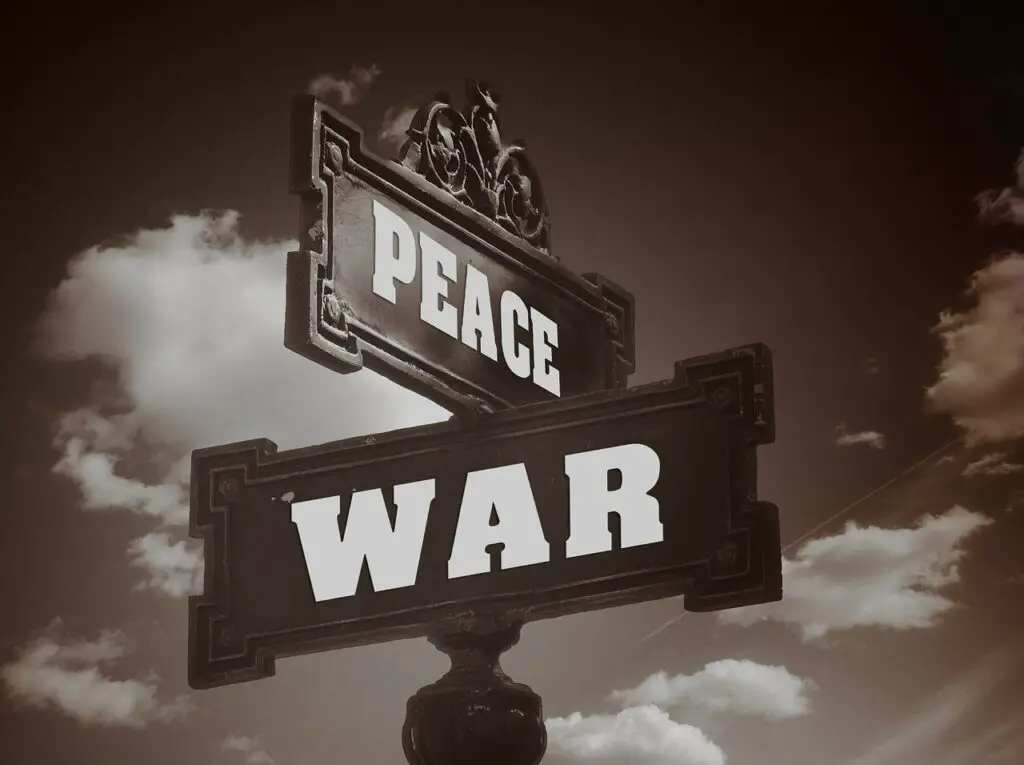We hope you enjoy our articles. Please note, we may collect a share of sales or other compensation from the links on this page. Thank you if you use our links, we really appreciate it!
February 2, 2022
The title of this article may be cliché, as hundreds if not thousands of articles, research papers, dissertations, and books have contained the similar title – and most reference the prelude to World War II. Neville Chamberlin infamously proclaimed “Peace in our time” as he held up a copy of the Munich Agreement. England and other European nations signed it, along with Adolf Hitler, allowing the German Nazi’s to take over the Sudetenland in western Czechoslovakia (now the Czech Republic and Slovakia) to avert war in 1938. Then, suddenly in 1939, war came.
By the time this article is posted, war may or may not have come to Europe again in the form of a Russian invasion of Ukraine. Nevertheless, U.S. President Joe Biden must walk a fine line in addressing the Ukrainian crisis. If Russia invades, and the Americans do little to nothing in a show of force or biting sanctions, Biden’s already dismal poll numbers at home would tank even further. There is nothing more damaging to a nation’s political leader than to show or appear to show weakness. Just ask Chamberlin, if he were still alive. But one could still ask former President Jimmy Carter.
However, if Biden overplays his hand and commits U.S. and other NATO troops to proximities too close to Russian troops, a wider and more catastrophic European military engagement could occur, not to mention the possibility of global conflict, and an unthinkable nuclear crisis – over Ukraine.
Think this absurd? Well, perhaps our historical perspective should not begin with pre-World War II but perhaps with pre-World War I. The world was ultimately entangled in a global war due to one lesser if not poorly military equipped country placing itself in the middle of two much larger military powers. And yes, there were also alliances of nations promised to come to the aid of other member nations should they be attacked or should they declare war on the opposing side. Sound familiar?
In 1914, the more powerful military countries opposing each other were the German and the Russian Empires – again the Russians! The Austro-Hungarian Empire – the military weaker country – was between Germany and Russia. The Austrians tied its fortunes with its bigger brother to the west, Germany. Unlike today, Russia did not necessary threaten the Austro-Hungarian Empire directly, but it’s smaller brother to the south, Serbia, wanted to break free from the Austrian sphere of influence. Smaller brothers, always rambunctious and unpredictable, fired the first shot. Well, actually an extremist fired the shots that killed the Archduke Ferdinand and his wife as they rode on their horse-drawn carriage down Sarajevo streets.
The rest, as they say, is history. The Austrians declared war on the Serbs after their onerous demands could not be met by the Serbs. Germans, obliged to come to Austrian defense, declared war on the Serbs as well. This Austro-Hungarian, German (and yes, even Italy for a time) alliance (and eventually others) is known in some circles as the Central Powers, and the Triple Alliance in others. Russia, whose Slavic ancestry tied them to the Serbs, came to their defense. France and England, who had a military alliance with each other, and Russia, also declared war on the Austrians and Germans. This Russian, English, French alliance is known as the Triple Entente. Soon most of Europe became embroiled in a continental conflict not seen since the Napoleonic era. This conflict brought in other continents since many European nations held colonies in other parts of the globe. Eventually, the U.S. joined the fight on the side of the Entente three years later. By 1917, the European conflict had become the Great War – aka World War I.
Stop! So, what does this regurgitated piece of history have to do with the twenty-first century crisis between Russia, the U.S. and Ukraine, you ask? Nothing. Perhaps everything. The difference between Austria-Hungary and Ukraine is that Austria-Hungary was already part of the alliance before war broke out. Ukraine is not part of NATO or any other alliance. This difference is crucial. Western and NATO diplomats must ask themselves what are the obligations to a nation not aligned with NATO, even though it wishes to be part of this alliance? What is binding and what is not? Can the Biden Administration provide substantial economic and military aid (like it does with Israel, South Korea, and Taiwan) to Ukraine and “unofficially” deter it from joining NATO, but “officially” not giving Russia any promises? Would this help “appease” Russian President Vladimir Putin but prevent Biden from looking weak in front of the world, and especially in his own country?
Another thing to consider is that the Austrians in 1914 wanted a war with Serbia (although there was some significant hesitation with Austria’s ally, Germany, to go to war).Ukraine is a different story entirely. In fact, the Ukrainian government, led by Volodymyr Zelenskyy, is denying that there is any real cause for alarm – and Zelensky’s government is just as perturbed at the U.S. as it is angry at the Russians. Ukraine is stating that the U.S. is just hyping up unnecessary tension. If the very nation under perceived threat is saying to stop with the war rhetoric and threats, then maybe both the U.S. and Russia should listen. Perhaps if Ukraine is not seen so much as a catalyst for war but as a way out of war and sanctions, it may also be a way for both the Americans and the Russians to save face.
It is first and foremost the Ukrainians’ lives that are at risk should war break out. If they are calling for calm, then the U.S. and Russia should follow suit. In the previous weeks and months, we have heard about Russian fears of being completely bordered on its west by NATO member nations. This is a rational fear; but Russia must want something other than a pre-1990s NATO (A January 20, 2022 article by Jonathan Masters for the Council on Foreign Relations is a succinct but comprehensive article detailing the expansion of NATO from its inception as well as what Russia is demanding from the U.S. and NATO). We have also heard why the U.S. and other NATO member nations fear Russian expanse into its former territories, and sphere of influence to hegemonic proportions in continental Europe. This is also a rational concern; but the U.S. and NATO member nations must want something more than continuous expansion into eastern Europe. And Ukraine – particularly its western part – fears Russian dominance; but it must want something too, beside NATO membership. In the present moment, to avoid a regional conflict from developing into a global catastrophe, a sense of security, not peace, should be the immediate concern and goal. This, I believe, the diplomats are making their focus. The Russians should feel secure that the U.S. will not encourage Ukrainian membership into NATO. The U.S. and NATO should feel secure that Russia won’t further invade Ukrainian territory. And Ukraine should feel safe from further Russian aggression and agitation. It is possible to avert war if cooler heads prevail. All sides in this geopolitical crisis can’t have it all, but for now, somewhere between unattainable peace and desperate appeasement lies the answer.



